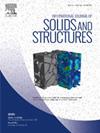Rate dependent self-healing model for cementitious materials
IF 3.4
3区 工程技术
Q1 MECHANICS
International Journal of Solids and Structures
Pub Date : 2024-12-14
DOI:10.1016/j.ijsolstr.2024.113196
引用次数: 0
Abstract
A new micromechanics-based constitutive model for self-healing cementitious materials is proposed. The model is aimed at self-healing materials with distributed healing mechanisms, such as materials with embedded microcapsules and enhanced autogenous healing capabilities. The model considers anisotropic microcracking and time-dependent healing. In contrast to many existing models for self-healing cementitious materials, the new approach imposes no limitations on the number or timing of microcracking or healing events that can be simulated. The formulation ensures that the simulation of microcracking and healing is always consistent with the second law of thermodynamics. The model is implemented in a three-dimensional nonlinear finite element code that allows structural elements formed from self-healing materials to be simulated. A series of single-point simulations illustrate the versatility of the model. The experiments considered with the model encompass a set of cylindrical specimens formed from concrete with embedded microcapsules containing sodium silicate, and a notched beam test series that examined the self-healing potential of concrete formed with a crystalline admixture. The validations show that the model can capture the characteristic mechanical behaviour of these structural elements with good engineering accuracy.
求助全文
约1分钟内获得全文
求助全文
来源期刊
CiteScore
6.70
自引率
8.30%
发文量
405
审稿时长
70 days
期刊介绍:
The International Journal of Solids and Structures has as its objective the publication and dissemination of original research in Mechanics of Solids and Structures as a field of Applied Science and Engineering. It fosters thus the exchange of ideas among workers in different parts of the world and also among workers who emphasize different aspects of the foundations and applications of the field.
Standing as it does at the cross-roads of Materials Science, Life Sciences, Mathematics, Physics and Engineering Design, the Mechanics of Solids and Structures is experiencing considerable growth as a result of recent technological advances. The Journal, by providing an international medium of communication, is encouraging this growth and is encompassing all aspects of the field from the more classical problems of structural analysis to mechanics of solids continually interacting with other media and including fracture, flow, wave propagation, heat transfer, thermal effects in solids, optimum design methods, model analysis, structural topology and numerical techniques. Interest extends to both inorganic and organic solids and structures.

 求助内容:
求助内容: 应助结果提醒方式:
应助结果提醒方式:


